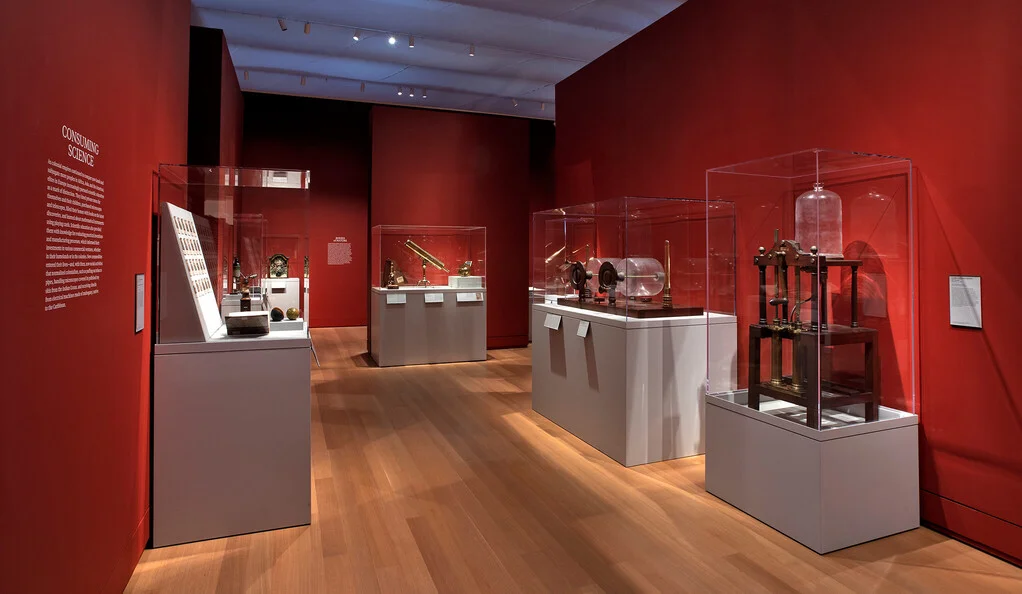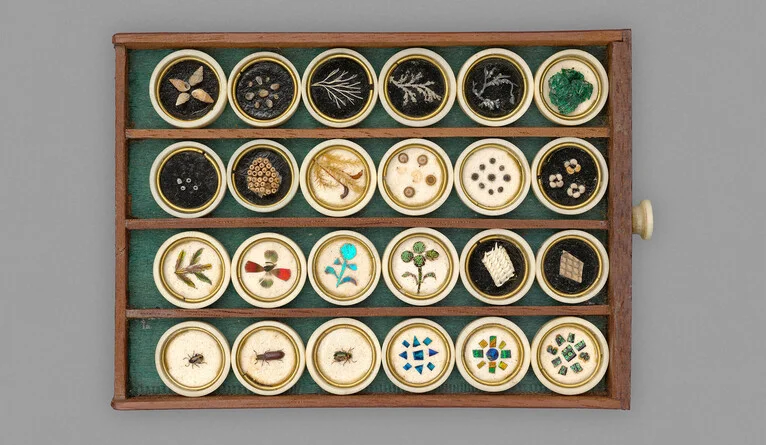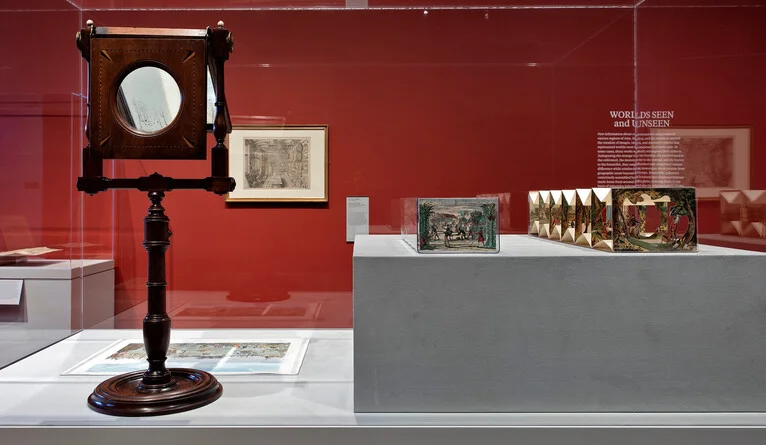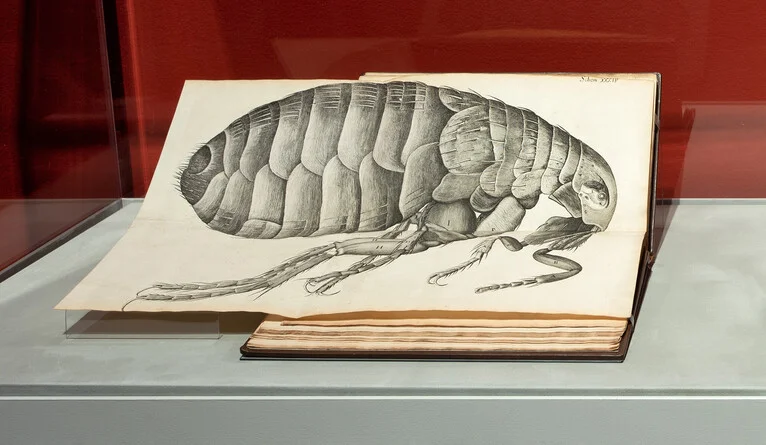“Crafting Worldviews,” an exhibition at Yale University Art Gallery, examines links between art and science — and lost narratives — in European colonialism.

“Crafting Worldviews,” an exhibition at Yale University Art Gallery, examines links between art and science — and lost narratives — in European colonialism. A tiny mahogany slipcase of microscope slides on display at the Yale University Art Gallery raises issues of conquest, colonialism, and empire.
The slipcase, created in the workshop of a Dutch diamond merchant and gem setter in the early 19th century, houses a set of 24 microscope slides of flora, fauna, and minerals collected from South America, Indonesia, and elsewhere. The specimens, including peacock feathers, butterfly wings, coral, and silver ore, are nestled like jewels in circular ivory mounts.
While aesthetically appealing, the slipcase has a complicated history. The same is true of all the objects presented in “Crafting Worldviews: Art and Science in Europe, 1500-1800,” an exhibition on view through June 25 at the art gallery that examines the relationship among art, science, and European colonialism from the 16th through the 18th centuries — an era of voyage, trade, and conquest on an unprecedented scale.
While the Crafting Worldviews Exhibition examines the development of Eurocentric worldviews, it also restores narratives, such as those of Indigenous and enslaved peoples, that traditionally have been overlooked in museum settings.
Visitors will encounter the slipcase in the show’s opening section between a collection of instruments for oceanic navigation and land surveying, including a compass, sextant, and octant, and a journal of the first lieutenant of a French slave ship that made a transatlantic voyage in 1732.

“The slipcase of slides is beautiful but it’s important to think about its material history, including the sourcing of the ivory, mahogany, and the specimens themselves” said Jessie Park, the Nina & Lee Griggs Assistant Curator of European Art and the co-curator of crafting worldviews exhibition.
“Specimens like these often crossed the sea aboard slave ships. It creates an upsetting dual reality in which exacting care went into preserving natural history specimens for scientific study while enslaved people experienced horrible neglect and suffering on the very same ships.”
Drawn from collections across the university, including a large selection of pieces from the Peabody Museum’s History of Science and Technology collection, the objects range from everyday items — books, maps, drafting tools, microscopes — to the unusual, such as 18th-century electricity generators, peep shows, and an automaton clock featuring the Roman goddess Diana. Most of the works presented were produced by artisans and craftspeople from three colonial empires: the British, French, and Dutch.
The show takes a unique approach to the display of historical scientific instruments, said Paola Bertucci, an associate professor of history and the history of medicine in Yale’s Faculty of Arts and Sciences and the curator of the History of Science and Technology Division of the Peabody Museum.
“When historical scientific instruments are displayed in art museums, their intricacy and aesthetic quality is usually highlighted,” said Bertucci.
“In other kinds of museum settings, they are presented as relics of old science and technology meant to remind visitors of great discoveries or the heroes of science like Galileo or Newton. We were interested instead in showing these objects in the context of European colonialism.”
To this end, the text on the Crafting Worldviews Exhibition labels and wall text do not call attention to the objects’ physical beauty.
“If you only emphasize beauty, you lose sight of the violent histories of the production of these beautiful objects,” Park said. “We selected objects of the highest aesthetic quality and that alone is enough to suggest to the viewer that they are beautiful and pleasing to look at. The labels describe the realities behind that beauty.”
Originally published at Yale News

While in many cases individual men took credit for making scientific instruments, the tools were crafted in workshops and households by numerous people, including women and children. For this reason, the show’s labels do not attribute objects to individuals but, when available, the maker’s signature is cited as it appears on a piece.
A section on makers and their workshops, Bertucci said, includes a 1737 map of North America that underscores how making the objects was a collective effort.
Commissioned by George Wildey, a British artisan who specialized in toys and optical instruments, the map functioned, in part, as an elaborate advertisement for his London shop as well as a celebration of the role various instruments played in Europe’s ongoing conquest of the Americas.
An image on the map’s periphery depicts a sexualized Indigenous woman standing near a vessel of coins, native plants and fruits, and foreign and imaginary animals. An inscription identifies members of the Gnacsitares, an Indigenous community from the eastern Great Plains, who contributed topographical information.
“The map celebrates conquest,” Bertucci said. “What’s interesting is that it was not produced based on the cartographers’ firsthand information, but through the knowledge of Indigenous people who helped them create it.”
A section called “Consuming Science” explores how Europeans of the age used science as a means of entertainment and enrichment. One case features a set of playing cards bearing representations of mathematical instruments — compasses, quadrants, levels, etc. — and a beautifully crafted pocket globe, roughly the size of a tennis ball, and its spherical case, the interior of which portrays a celestial map.

“You were holding the universe in the palm of your hand,” Bertucci said. “Who carried this in their pocket? Probably a gentleman who would present it at the first opportunity in conversation, perhaps at a soiree, and show off the novelty of it, as we might with the latest iPhone.”
Contraptions like an electricity machine on display were the featured entertainment at 18th-century parties in Europe and its colonies, generating stimulating spectacles of electrical sparks. The machine, which is composed of two large glass cylinders with hand cranks set in a base of mahogany — wood with a complicated history, Bertucci explained.
“Mahogany is native to the Caribbean where Europeans started sugar plantations,” she said. “They used enslaved Africans to fell the mahogany trees to make space for the plantations. The wood was brought to Britain where it became a fashionable colonial commodity for furniture making.”

Another section, “Bodies of Nature,” illuminates how Europeans viewed scientific research as a means to reveal the secrets of nature. It includes anatomical representations, a strikingly accurate 17th-century rendering of a flea created with the aid of a microscope, and examples of lavishly detailed frontispieces to scientific tomes that depict knowledge as a naked European woman shrouded in a veil surrounded by exoticized and stereotypical figures representing Africa, Asia, and the Americas.
A pair of peepshows — a series of illustrated prints inserted into wooden or cardboard boxes and viewed through peep holes to create an immersive experience — are featured in “Worlds Seen and Unseen,” a section exploring the ways Europeans imagined the vast expanses of the globe that most of them had never seen. One peepshow created in 1825 presents a serene scene set in London’s Regent’s Park.
In contrast, the other, dated to about 1750, depicts a Caribbean sugar plantation where enslaved African people toil under the eye of Europeans.
“In a sense, it is a very violent image,” Park said. “You see an overseer wielding a beating rod to threaten various enslaved people cutting sugar cane and boiling sugar juice. But the peepshow served to normalize slavery and make it entertaining to look at in the same way people enjoyed viewing the scene from Regent’s Park.”
Originally published at Yale News

A section called “Clockwork Cosmologies” presents various intricate clockwork mechanisms, inviting viewers to ponder the order of the universe just as Europeans did 300 years ago. Objects on display include an orrery — a mechanical model of the solar system — a 16th-century astrolabe used to calculate the position of astronomical objects, and the captivating automaton of Diana wielding a bow and riding a chariot pulled by two African panthers.
Two books included in the same case, presented at angles with each other rather than side by side, capture the theme of Crafting Worldviews Exhibition. One, a book of ingenious machine designs published in France in 1588, is opened to an illustration of a European man working a complex and purely imaginative double mill. The worker appears entirely at ease in his labor.
The other, a 17th-century Dutch atlas, is opened to a map of Pernambuco, Brazil that includes an illustration of a sugar plantation. As in the neighboring image, the people depicted appear comfortable in their work, a striking misrepresentation of enslaved labor.
“This is another sanitized depiction of a sugar plantation,” she said. “In reality, the enslaved Africans got their limbs amputated by the machines. They died from exhaustion, dehydration, violence, and neglect while boiling sugar in the tropical climate. And none of that is shown here.”
Originally published at Yale News